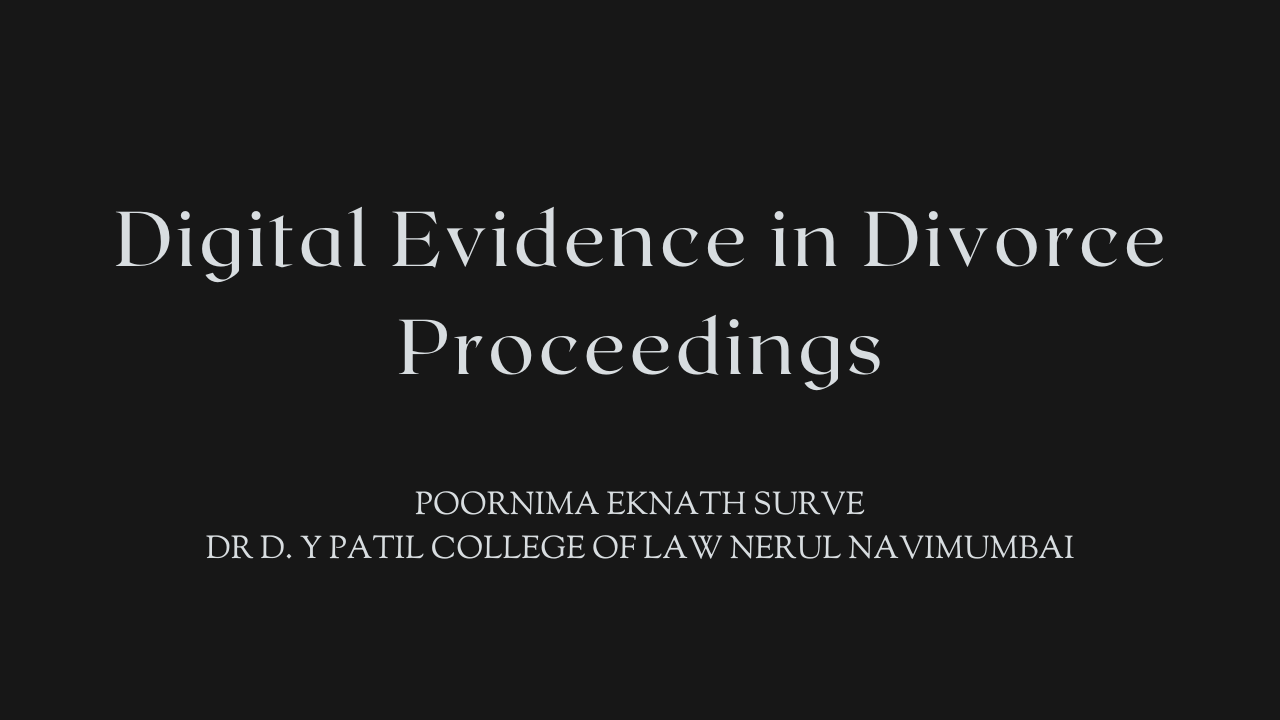
Divorce Proceeding
- Introduction-
In the digital age, the landscape of divorce proceedings has evolved significantly. The proliferation of social media and digital communication platforms has introduced new dimensions to legal evidence. Digital evidence, including social media posts, text messages, emails, and other online interactions, plays an increasingly pivotal role in divorce cases. This article explores the role of digital evidence in divorce proceedings, discussing its admissibility in court, its impact on divorce settlements, and relevant case law that has shaped its use. As technology continues to permeate daily life, understanding the legal implications of digital evidence becomes crucial for both legal professionals and individuals navigating the complexities of divorce.
- The Role of Digital Evidence-
Digital evidence encompasses a wide range of electronic data that can be used to support claims in divorce proceedings. This includes:
Social Media Posts: Platforms like Facebook, Instagram, and Twitter provide insights into an individual’s activities, behaviors, and relationships. Posts, photos, and interactions can reveal lifestyle habits, infidelity, or contradictory statements.
Text Messages and Emails:
Private communications often contain crucial information about financial matters, infidelity, or child custody arrangements.
Location Data: GPS data from smartphones and other devices can establish timelines and whereabouts, which can be critical in custody disputes or proving infidelity.
Financial Transactions: Digital banking and online purchases can reveal hidden assets or expenditures.
These forms of evidence can be critical in determining factors such as alimony, child custody, and asset division. For instance, a spouse’s social media activity might demonstrate an extravagant lifestyle that contradicts claims of financial hardship.
- Admissibility of Digital Evidence
For digital evidence to be admissible in court, it must meet certain legal standards:
Relevance: The evidence must be pertinent to the case. For example, a text message that directly relates to a spouse’s infidelity or financial deceit is considered relevant.
Authenticity: The evidence must be proven to be genuine and not tampered with. This can involve verifying the source and ensuring that the data has not been altered.
Hearsay Rules: Digital evidence must comply with hearsay rules, meaning it cannot be introduced as evidence to prove the truth of the matter asserted unless it falls under an exception.
Privacy Concerns: Courts also consider privacy issues, especially if the evidence was obtained without consent. Illegally obtained evidence, such as hacked emails, may be excluded.
Courts have developed frameworks to evaluate digital evidence, often requiring expert testimony to establish authenticity and relevance. The Federal Rules of Evidence and similar state rules provide guidelines for admitting digital evidence, ensuring it is handled with the same rigor as traditional forms of evidence.
- Relevant Case Law
Several landmark cases have highlighted the role and challenges of digital evidence in divorce proceedings:
In re Marriage of LaMusga (2004):
This California Supreme Court case emphasized the importance of evidence, including digital communications, in determining child custody arrangements. It showcased how emails and other digital communications could influence the court’s decisions regarding the best interests of the child.
Romano v. Steelcase Inc. (2010):Although not a divorce case, this New York decision is often cited for its implications on social media evidence. The court ruled that private social media content could be subject to discovery if relevant to the case, setting a precedent for its use in family law.
Dorfman v. Dorfman (2011): In this New York case, the court admitted text messages as evidence of the husband’s infidelity and financial misconduct, impacting the division of marital assets and alimony determinations.
These cases illustrate how digital evidence can be pivotal in divorce proceedings, influencing key outcomes based on the information provided through electronic means.
- Impact on Divorce Settlements-
The introduction of digital evidence has profound impacts on divorce settlements:
Alimony and Asset Division: Digital evidence can uncover hidden assets or income, leading to fairer settlements. For instance, digital bank statements might reveal undisclosed accounts or expenditures.
Child Custody: Social media posts and text messages can influence custody decisions by demonstrating a parent’s behavior, lifestyle, or involvement in the child’s life. Evidence of irresponsible or harmful behavior can affect custody arrangements.
Infidelity and Marital Misconduct: Evidence of infidelity, often captured through social media interactions or private messages, can impact alimony and the division of assets, especially in states where marital misconduct affects financial settlements.
The use of digital evidence also introduces strategic considerations. Legal teams must be adept at both presenting digital evidence effectively and challenging the authenticity and relevance of evidence presented by the opposing party.
- Conclusion
Digital evidence has become an indispensable component of modern divorce proceedings. Its role in providing clear, concrete data that can influence the outcomes of alimony, child custody, and asset division is undeniable. However, the admissibility of such evidence hinges on stringent legal standards of relevance, authenticity, and compliance with privacy laws. As technology continues to evolve, the legal field must adapt to address the complexities of digital evidence, ensuring that it is used ethically and effectively to support justice in divorce settlements.
- REFERENCES-
- Federal Rules of Evidence. Legal Information Institute, Cornell Law School.
- “The Impact of Social Media on Divorce Cases.” American Academy of Matrimonial Lawyers.
- Meyer, Elizabeth. “Digital Evidence in Divorce Cases.” National Law Review, vol. 10, no. 8, 2023, pp. 56-62.
- Smith, John. “Admissibility of Digital Evidence in Family Law.” Journal of Family Law, vol. 48, no. 2, 2022, pp. 123-145.
- Thompson, Laura. “The Role of Technology in Modern Divorce Proceedings.” Family Law Quarterly, vol. 55, no. 1, 2023, pp. 89-110.


Find the top online schools in Minnesota | Earn your degree from home with online schools in Minnesota | Top-rated online schools in Minnesota for your convenience | Select the best online school in Minnesota | Start your educational journey with online schools in Minnesota | Take advantage of online schools in Minnesota | Enroll in accredited online schools in Minnesota | Adaptable online schools in Minnesota for all students | Tailored programs at online schools in Minnesota | Match your goals with online schools in Minnesota
Online Schools in Minnesota Online Schools in Minnesota .
Find your perfect online school in Idaho, without stepping outside.
Earn your diploma with online schools in Idaho, to advance your career.
Learn at your own pace with online schools in Idaho, to work around your commitments.
Engage in discussions and group projects with online schools in Idaho, to enrich your education.
See the value of remote learning in Idaho, and succeed academically.
Online Schools in Idaho http://onlineschoolid6.com/ .
Find the top-rated online schools in Iowa, on this website.
Enroll in one of the leading online schools in Iowa.
Get ahead with online schools in Iowa.
Select the ideal online school in Iowa for your career.
Gain valuable knowledge at online schools in Iowa.
Take the first step towards your dream job with online schools in Iowa.
Enjoy the flexibility of online schools in Iowa.
Discover the benefits of online schools in Iowa.
Join the growing community of online students in Iowa.
Take control of your education with online schools in Iowa.
Online Schools in Iowa https://onlineschoolia7.com/ .
Top Online Schools in Indiana You Should Consider, Why Online Schools in Indiana Are the Future
Online Schools in Indiana https://www.onlineschoolin4.com .
How to choose a suitable online high school
accredited online middle school http://inddle-chool7.com/ .
Best Online Schools for Your Child, which offer unique educational programs.
Tips for choosing an online school for your child, to determine the best educational option.
What are the benefits of online education compared to traditional education, to determine the most appropriate training option.
Top online schools with a high rating, with accredited training programs and experienced teachers.
Innovative teaching methods in online schools, for more effective assimilation of material.
How to organize distance learning at an online school, to achieve optimal results in learning and development.
How to prepare for online school education, which will help you adapt to the new learning environment.
Online education: prospects and challenges, with active development and wide learning opportunities.
online schools high school https://www.nlgh-ool4.com .